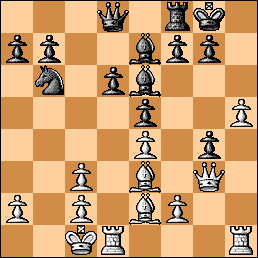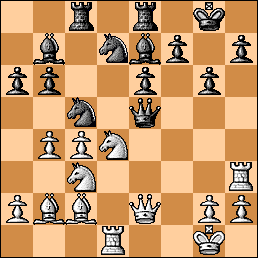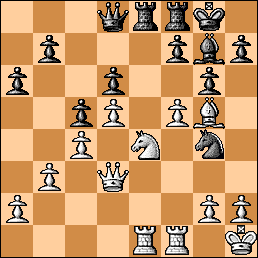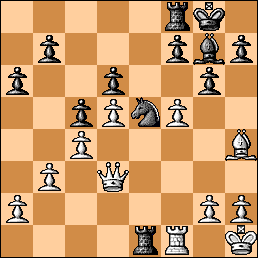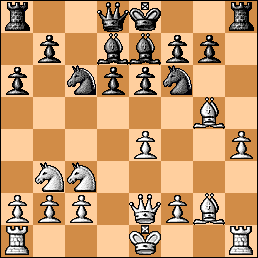Here are three very interesting 5 minute games I contested recently on ICC.
Use them as tactical training devices.
Game 1.
Impitoyable (Unforgiven) vs Aries2 Game/5 Keres Attack
Here’s more information about the Frenchman Impitoyable from his ICC finger notes:
Information about Impitoyable (Last disconnected Sun Jun 19 2011 15:10):
rating [need] win loss draw total best
Wild 2206 [1] 645 143 31 819 2301 (03-Jan-2011)
Loser’s 2037 [4] 1360 529 55 1944 2232 (10-Jul-2008)
Bughouse 1915 [6] 23 15 0 38 2011 (30-Nov-2006)
Crazyhouse 2244 [6] 863 307 0 1170 2307 (16-Feb-2008)
Bullet 2516 [8] 1229 543 83 1855 2706 (27-May-2008)
Blitz 3091 [8] 750 459 133 1342 3175 (29-Sep-2009)
Standard 2657 [6] 184 29 12 225 2682 (19-Nov-2010)
5-minute 2614 1237 445 181 1863 2726 (14-Oct-2009)
1-minute 2570 [8] 1493 945 121 2559 2570 (27-Jun-2010)
15-minute 2475 89 5 2 96 2475 (19-Jun-2011)
3-minute 2356 433 183 56 672 2519 (17-Apr-2011)
45-minute 1692 [4] 1 0 0 1
Chess960 2093 457 130 31 618 2213 (14-Jul-2010)
1: “Impitoyable” : french title for the film “Unforgiven”, by and with C.
Eastwood (and G. Hackman, R. Harris, M. Freeman …) ; but “impitoyable”
means rather “pityless” or “mercyless” ; I will nevertheless accept takebacks
for obvious mouseslips and ask for them … only in that case of course.
2: International Master since 1996 ; maths teacher since 2001.
3: Can you queen your f-pawn as early as move 18 playing black ? See my
liblist, game Index 4 !
4: You may improve your play in knights endings by analysing my defeat versus
Vidocq, game numbre 16.
5: You don’t get a chance each day to play as Morphy did at the Sevilla Opera.
Egor Geroev-2 had this chance, see my lybrary game number 18 (after 15 …
Qxb5 16 Nc7+! ; Rxc7 17 Rd8 it’s exactly the same mate !)
He has a very good score against me overall. I was looking to improve my statistics by following an obscure recommendation of Kasparov and Nikitin versus the popular Keres Attack.
1. e4 c5 2. Nf3 d6 3. d4 cxd4 4. Nxd4 Nf6 5. Nc3 e6 6. g4 Nc6 7. g5 Nd7 8. Be3 Be7 9. h4 O-O 10. Qd2
Often times white likes to put his queen out on the aggressive h5 square. Then, black can follow the same plan as in the game!
10…Nxd4 Part of a sequence that gives black freedom of movement.
11. Qxd4 e5 12. Qd1 Nb6!?
The interesting proposal of Kasparov and Nikitin from an ancient book on the Scheveningen. White can opt to eat this horse with Be3xb6 to gain control of d5 but that move is definitely not on most attacking players’ radar screens. They just want to give mate.
13. g6?! This has to be too soon.
13…hxg6 14. h5 g5 15. Qf3 g4 16. Qg3 Be6 17. O-O-O Rc8 18. Be2 Rxc3! 19. bxc3
19…d5 20. Bxg4 Ba3+ 21. Kd2 Nc4+ 22. Ke2 Nxe3 23. fxe3 Qc8 24. Rhg1 Qxc3 25. Bxe6 Qxc2+ 26. Rd2 Qc4+ 27. Kd1 Qa4+ 28. Rc2 {Black resigns} 1-0
Why do I award black’s 18th move an exclamation point and then go on to lose in short order? That’s the puzzle for you – identify the beautiful missed black win! Immediately after the game I had the feeling I had blown a promising position but I didn’t know how promising until I checked with Rybka 4. Embarrassing, black was totally winning!
Game 2
Let’s follow this embarrassing blown win with another embarrassing blown win, shall we? This time we are dominating and crushing Logofet.
Some more information about Logofet:
Information about Logofet (Last disconnected Sun Jun 19 2011 12:08):
rating [need] win loss draw total best
Crazyhouse 1798 [6] 0 2 0 2
Bullet 2252 [8] 155 203 30 388 2433 (30-Jan-2006)
Blitz 2749 1404 1703 342 3449 3022 (21-Mar-2008)
Standard 2637 [6] 4 2 0 6
5-minute 2588 2563 1459 410 4432 2624 (30-Mar-2009)
1-minute 2250 4538 3640 525 8703 2508 (21-Aug-2009)
15-minute 1953 [4] 3 0 0 3
3-minute 1873 [8] 1 0 0 1
I seem to remember that Logofet is GM Alex Lenderman. Let’s see the game.
1. Nf3 c5 2. c4 b6 3. Nc3 Bb7 4. e4 d6 5. d4 cxd4 6. Nxd4 Nf6 7. Bd3 e6 8.
O-O Be7 9. Qe2 Nbd7 10. b3 O-O 11. Bb2
I love this attacking set up vs. the Hedgehog. GM Nunn extolled its virtues way back in the early 1980s in a Philips & Drew tournament book.
I always show campers a forced win I missed vs GM Yudasin as well as a one-sided win over Teddy Coleman in the exact same line. White’s pieces are all supremely active and pointed at black’s king.
Nc5 12. Bc2 Rc8 13. Rad1 Qc7 14. f4 a6 15. Rf3! g6 16. Rh3 Rfe8
It’s time to act and roll up Logofet.
17. e5! dxe5 18. fxe5 Nfd7 19. b4! Qxe5
A forced sacrifice. Dismal, but true. Now I go nuts and hand my hand on a silver platter.
20. bxc5 Bxc5 21. Qxe5 Nxe5 22. Ne4 Nxc4 23. Nf6+ Kf8 24. Ba1 Red8 25. Rf1 Rxd4 26.
Bxd4 Bxd4+ 27. Kh1 Bxf6 28. Rxf6 Kg7 29. Rf2 Bd5 {White forfeits on time}
0-1
Challenge for the readers – point out the several wins I missed. As a bonus, point out the easiest and most crushing of all the missed wins.
Game 3
Lest we get the impression I am always blowing winning positions, here is one where a nice tactic emerged and I also got the point.
FM Drunkenight – IM Aries2 Benoni
1. Nf3 Nf6 2. c4 d6 3. Nc3 g6 4. d4 Bg7 5. e4 O-O 6. Be2 c5 7. O-O Bg4 8. d5 a6 9. Be3 Nbd7 10. Nd2 Bxe2 11. Qxe2 Qc7 12. Kh1 Rae8 13. f4 e6
This basic setup with a-rook on e8 I got from some obscure Spassky games dating back to the 1960s.
14. Rae1 exd5 15. exd5 Qb6 16. b3 Qb4 17. Ncb1 Ne4 18. Qd3 Ndf6 19. f5 Nxd2 20. Bxd2 Qb6 21. Nc3 Ng4 22. Ne4 Qd8 23. Bg5
23…Rxe4! A comprehensive refutation of white’s pin operation.
24. Bxd8 Rxe1 25. Bh4 Ne5!
This was a very pleasing move to play at the end of the combination! A very unusual overloading where white’s queen cannot stay in touch with the rook. Of course, White can resign now. He played on, since it is blitz.
26. Rxe1 Nxd3 27. Re7 gxf5 28. Rxb7 Nc1 29. Rb6 Nxa2 30. Rxd6 Nb4 31. Rd7 Be5 32. Be7 Rc8 33. d6 Nc6 34. Rb7 Nxe7 35. dxe7 Re8 36. Ra7 Kg7 37. Rxa6 Rxe7 38. Rc6 Bd4 39. g3 Rb7 40. Kg2 Rxb3 41. Kh3 Rc3 42. Rc7 Rxc4 43. Rd7 Bf6 44. Rd6 Rd4
45. Rc6 c4 46. Rc7 Re4 47. Rc8 c3 48. Rc6 Re2 49. Rc5 c2 50. Rc4 Bb2
{White resigns}
0-1
Good times! Well in Game 3. Not in Games 1 or 2.
Shindig Chess
On June 14, an online tournament was held. These GM players won in a five-round game/15 event:
| Mark | Baadur | |
| 1 | ♘f3 | ♞f6 |
| 2 | ♙c4 | ♟g6 |
| 3 | ♘c3 | ♝g7 |
| 4 | ♙e4 | ♟d6 |
| 5 | ♙d4 | ♚0-0 |
| 6 | ♗e2 | ♞a6 |
| 7 | ♔0-0 | ♟e5 |
| 8 | ♖e1 | ♟c6 |
| 9 | ♖b1 | ♞c7 |
| 10 | ♙d5 | ♟cxd5 |
| 11 | ♙cxd5 | ♞h5 |
| 12 | ♙g3 | ♟f5 |
| 13 | ♘d2 | ♞f6 |
| 14 | ♙f3 | ♟h5 |
| 15 | ♙a4 | ♟h4 |
| 16 | ♘c4 | ♟hxg3 |
| 17 | ♙hxg3 | ♞h5 |
| 18 | ♔g2 | ♞e8 |
| 19 | ♖h1 | ♟f4 |
| 20 | ♙g4 | ♞g3 |
| 21 | ♖h3 | ♞f6 |
| 22 | ♖xg3 | ♟fxg3 |
| 23 | ♔xg3 | ♞e8 |
| 24 | ♗e3 | ♜f7 |
| 25 | ♕g1 | ♝f6 |
| 26 | ♗xa7 | ♜xa7 |
| 27 | ♕xa7 | ♟b5 |
| 28 | ♕xf7+ | ♚xf7 |
| 29 | ♘xb5 | ♝g5 |
| 30 | ♖h1 | ♚g7 |
| 31 | ♙b4 | ♝a6 |
| 32 | ♘ba3 | ♝xc4 |
| 33 | ♘xc4 | ♞f6 |
| 34 | ♙b5 | ♞d7 |
| 35 | ♙a5 | ♞c5 |
| 36 | ♙a6 | ♛b8 |
| 37 | ♖a1 | ♞b3 |
| 38 | ♙a7 | ♛h8 |
| 39 | ♙a8Q | ♝f4+ |
| 40 | ♔f2 | ♛h4+ |
| 41 | ♔f1 | ♛h1+ |
| 42 | ♔f2 | ♞xa1 |
| 43 | ♘xd6 | ♛h2+ |
| 44 | ♔f1 | ♛h3+ |
| 45 | ♔f2 | ♛h2+ |
| 46 | ♔f1 | ♛h1+ |
| 47 | ♔f2 | ♛h2+ |
| 48 | ♔f1 | ♛h3+ |
| 49 | ♔f2 | ♛g3+ |
| 50 | ♔f1 | ♛h3+ |
| 51 | ♔f2 | ♛g3+ |
| 52 | ♔f1 | ♛h3+ |
| Time Remaining: 00:46 | Time Remaining: 00:04 |
Draw (this is the way Shindig outputted the game and emailed it to me).
Chess U News
- Frank Johnson will author Chess-Coach 101, 102, and 103 for his chess schools and beyond.
- Kamran Shirazi’s paper bag of recent scoresheets has been located and Jones Murphy and Kamran will select 10 good recent Shirazis for packaging into Shirazi 201.
- I am working on Tal 301, a labyrinth of complications as one might expect.
- Mountaindog is working on Classics 101, the ten most famous games of all time.
- Marcel Martinez is working on Middlegame 201, 10 of his interesting efforts vs. luminaries such as Conquest, Hess, etc.
